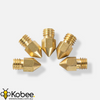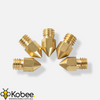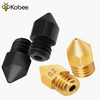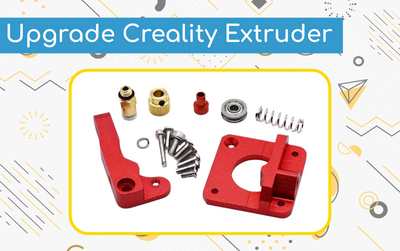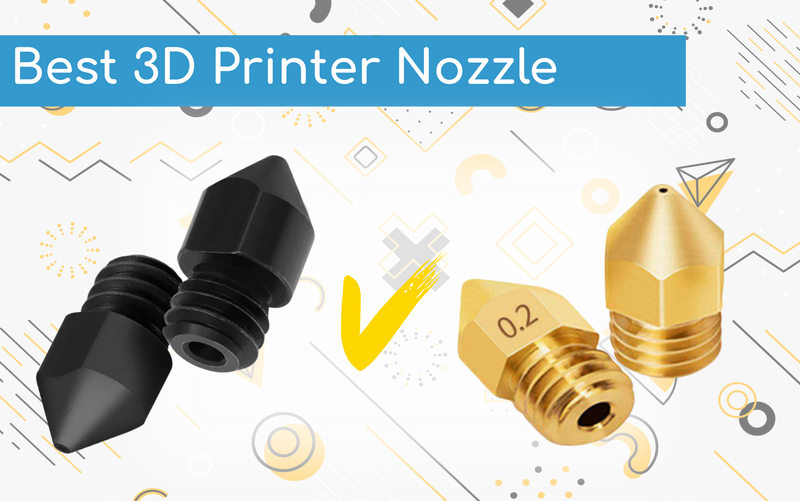
Brass vs Hardened Steel 3D Printer Nozzles: Which Should You Choose?

Introduction
Choosing the right 3D printer nozzle can significantly impact print quality, speed, and durability. With countless options available on the market today, finding the perfect nozzle for your specific printing needs can feel overwhelming.
Whether you're a casual hobbyist who only replaces nozzles when they're worn down or a meticulous 3D printing enthusiast who optimizes every component, this comprehensive guide will help you understand the different types of nozzles, their ideal applications, and how to select the perfect one for your projects.
Brass Nozzles: The Industry Standard
Key Benefits of Brass Nozzles:
- Efficiently transfers heat from the heat block to your filament
- Helps maintain consistent temperatures for better print quality
- Most affordable nozzle option for everyday printing
- Standard on most consumer 3D printers
If you own a 3D printer, it likely came equipped with a brass nozzle. This isn't a coincidence, brass has become the industry standard due to its exceptional heat conductivity properties. This excellent thermal efficiency makes brass nozzles ideal for maintaining consistent temperatures, resulting in smoother, more reliable prints.
However, brass does have one significant drawback: its relatively soft. This softness becomes problematic when printing with abrasive materials. Filaments containing carbon fiber, wood, metal particles, or other abrasive components will gradually wear down brass nozzles, causing them to lose dimensional accuracy and produce inconsistent results.
Hardened Steel Nozzles: For Demanding Materials
Key Benefits of Hardened Steel Nozzles:
- Withstands abrasive filaments without significant wear
- Maintains accuracy even after extensive use with abrasive materials
- Requires less frequent replacement when printing with specialty filaments
- Delivers predictable results over time with challenging materials
Where brass nozzles fall short in durability, hardened steel nozzles excel. These heat-treated steel nozzles are specifically engineered to resist wear from highly abrasive materials, making them invaluable for printing with composite filaments.
The tradeoff comes in the form of reduced thermal conductivity. Hardened steel doesn't transfer heat as efficiently as brass, which can affect temperature consistency. However, this limitation can be compensated for by printing at slightly higher temperatures (typically 5-10°C higher than with brass). This temperature adjustment provides your printer with the necessary thermal margin to maintain optimal melting conditions.
Once properly calibrated for the slightly different thermal properties, a hardened steel nozzle will allow you to print with abrasive materials. The major advantage is longevity. You can trust that your nozzle diameter remains consistent over many prints, delivering reliable quality without constant monitoring or replacement.
| Filament Material | Recommended Nozzle Type |
|---|---|
| PLA | Brass |
| ABS | Brass |
| PETG | Brass |
| TPE | Brass |
| HIPS | Brass |
| Nylon | Brass |
| Carbon Fiber | Hardened Steel |
| Metal-Filled | Hardened Steel |
| Wood-Filled | Hardened Steel |
| Glow-in-the-Dark | Hardened Steel |
Other Nozzle Materials Worth Considering
Stainless Steel Nozzles
Stainless steel nozzles are somewhere between brass and hardened steel. Bambulab printers have been shipping with stainless steel nozzles pre installed. Some of the advantages include:
- Better wear resistance than brass (though not as durable as hardened steel)
- Food-grade material that minimizes contamination (See Note on this)
- Suitable for applications where material purity is important
- Lower thermal efficiency compared to brass
Composite/Assembled Nozzles
These nozzles combine multiple materials to leverage their respective strengths:
- Brass body for excellent heat transfer
- Hardened interior lining for wear resistance against abrasive materials
- Offers a "best of both worlds" approach
Although you will get marginal improvements from the use of these nozzles, theyre not going to be worth the investment for the casual printer (In our humble opinion)
Choosing the Right Nozzle Diameter
Beyond material type, nozzle diameter plays a crucial role in print quality and speed. Standard diameters range from 0.1mm to 1.0mm, with 0.4mm being the most common default size.
When selecting a nozzle diameter, consider the trade-off between detail precision and print speed:
- Smaller Nozzles (0.1mm - 0.3mm):
These provide high detail and finer resolution, making them ideal for intricate models, miniatures, and parts requiring precise tolerances. However, they significantly increase print time and are more prone to clogs, especially with composite filaments. - Standard Nozzle (0.4mm):
The default choice for most 3D printers, balancing detail and speed. It works well for general-purpose prints, offering good resolution while maintaining a reasonable print time. It also supports a wide range of materials with fewer clogging issues. - Large Nozzles (0.5 - 1.0mm):
These increase print speed by extruding more filament per pass, making them suitable for large, less detailed prints and functional parts where surface finish is less critical. They are also better suited for printing abrasive or fiber-filled materials due to their wider openings, reducing the risk of blockages. However, finer details may be lost, and layer lines become more visible.
| Smaller Nozzles (<0.4mm) | Larger Nozzles (>0.4mm) |
|---|---|
|
✓ Higher precision and detail ✓ Better quality overhangs ✓ Easier support removal ✓ Nearly invisible layer lines |
✓ Dramatically reduced print times ✓ Fewer nozzle-related print failures ✓ Reduced clogging with filled filaments ✓ Structurally stronger prints |
|
✗ Significantly longer print times ✗ Higher risk of clogging |
✗ More visible layer lines ✗ Lower detail precision |
What's the Best Nozzle for Your Needs?
The "best" nozzle depends entirely on your specific printing requirements. Some things to consider include:
- Will you be printing with standard or abrasive filaments?
- Do you need fine details or faster prints?
- Are structural properties more important than aesthetics?
- How often do you print and how quickly do you need results?
Recommendation for Beginners
If you're new to 3D printing or primarily use basic materials like PLA, ABS, or PETG, a 0.4mm brass nozzle is your best starting point. This combination offers the ideal balance of versatility, print quality, and ease of use.
For Advanced Users
Consider keeping a selection of different nozzle types and sizes to optimise for specific projects:
- 0.2mm brass for highly detailed miniatures or jewelry
- 0.4mm brass for everyday printing
- 0.4mm hardened steel for occasional abrasive materials
- 0.6mm or 0.8mm nozzle for rapid prototyping or structural parts
Shop Our Nozzle Collection
We offer a comprehensive range of high-quality nozzles in our store, from precision 0.1mm brass nozzles to heavy-duty 1.0mm hardened steel options. Browse our selection below to find the perfect nozzle for your next 3D printing project!
Hey there! Thanks for stopping by
We hope you found what you were looking for and were able to step away knowing just that little bit more
Founded by a group of electrical engineers, Kobee's main goal is to simplify electronics design and home automation and making it accesible to everyone, not just the engineering community. In many of our own personal maker journeys we were able to benefit from the amazing open source and community driven content generated by savvy makers all over the world. Though, the issue we always found is that although the content was readily available, the documentation and explanation was sometimes barebones and better suited to the experts that designed it in the first place. We're looking to change that! To explain it as simply and as clearly as we can and to pay it forward to the open source community that we all love

So what can you expect from us? Its unlikely you'll find an in depth explanation of laplace transform here and we're probably not going to delve into the world of imaginary numbers (Sorry). But, if you're looking for straight forward, to the point and simple to understands tutorials, explanations and project examples; we think we just might have you covered.
Our community is at the heart of what we do, so if you have any comments or questions leave them in the comments down below or use the Contact Us Form to get in touch. We'll do our best to help each and every one of you

